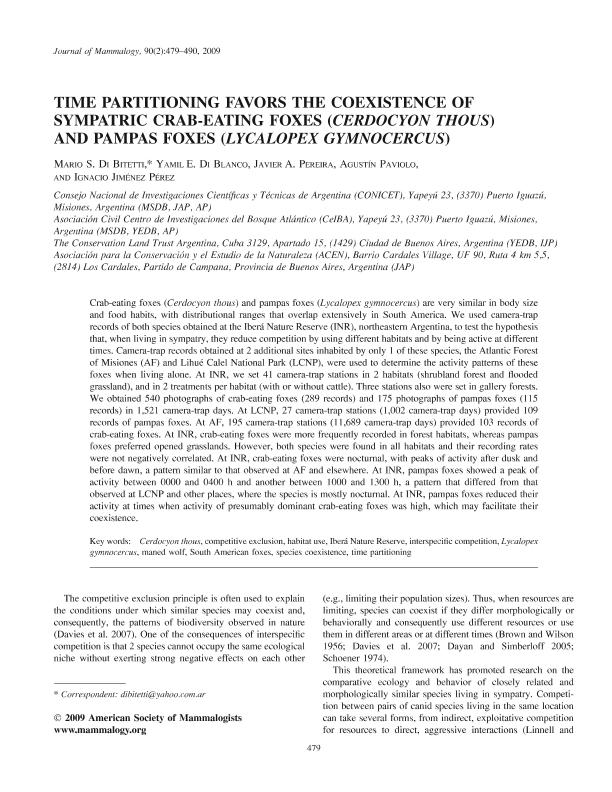Mostrar el registro sencillo del ítem
dc.contributor.author
Di Bitetti, Mario Santiago

dc.contributor.author
Di Blanco, Yamil Edgardo

dc.contributor.author
Pereira, Javier Adolfo

dc.contributor.author
Paviolo, Agustin Javier

dc.contributor.author
Jiménez Pírez, Ignacio
dc.date.available
2018-09-17T17:50:22Z
dc.date.issued
2009-04
dc.identifier.citation
Di Bitetti, Mario Santiago; Di Blanco, Yamil Edgardo; Pereira, Javier Adolfo; Paviolo, Agustin Javier; Jiménez Pírez, Ignacio; Time partitioning favors the coexistence of sympatric crab-eating fox (cerdocyon thous) and pampas foxes (lycalopex gymnocercus); Alliance Communications Group Division Allen Press; Journal of Mammalogy; 90; 2; 4-2009; 479-490
dc.identifier.issn
0022-2372
dc.identifier.uri
http://hdl.handle.net/11336/59904
dc.description.abstract
Crab-eating foxes (Cerdocyon thous) and pampas foxes (Lycalopex gymnocercus) are very similar in body size and food habits, with distributional ranges that overlap extensively in South America. We used camera-trap records of both species obtained at the Ibera´ Nature Reserve (INR), northeastern Argentina, to test the hypothesis that, when living in sympatry, they reduce competition by using different habitats and by being active at different times. Camera-trap records obtained at 2 additional sites inhabited by only 1 of these species, the Atlantic Forest of Misiones (AF) and Lihue´ Calel National Park (LCNP), were used to determine the activity patterns of these foxes when living alone. At INR, we set 41 camera-trap stations in 2 habitats (shrubland forest and flooded grassland), and in 2 treatments per habitat (with or without cattle). Three stations also were set in gallery forests. We obtained 540 photographs of crab-eating foxes (289 records) and 175 photographs of pampas foxes (115 records) in 1,521 camera-trap days. At LCNP, 27 camera-trap stations (1,002 camera-trap days) provided 109 records of pampas foxes. At AF, 195 camera-trap stations (11,689 camera-trap days) provided 103 records of crab-eating foxes. At INR, crab-eating foxes were more frequently recorded in forest habitats, whereas pampas foxes preferred opened grasslands. However, both species were found in all habitats and their recording rates were not negatively correlated. At INR, crab-eating foxes were nocturnal, with peaks of activity after dusk and before dawn, a pattern similar to that observed at AF and elsewhere. At INR, pampas foxes showed a peak of activity between 0000 and 0400 h and another between 1000 and 1300 h, a pattern that differed from that observed at LCNP and other places, where the species is mostly nocturnal. At INR, pampas foxes reduced their activity at times when activity of presumably dominant crab-eating foxes was high, which may facilitate their coexistence.
dc.format
application/pdf
dc.language.iso
eng
dc.publisher
Alliance Communications Group Division Allen Press

dc.rights
info:eu-repo/semantics/openAccess
dc.rights.uri
https://creativecommons.org/licenses/by-nc/2.5/ar/
dc.subject
Cerdocyon Thous
dc.subject
Competitive Exclusion
dc.subject
Habitat Use
dc.subject
Iberá Nature Reserve
dc.subject
Interspecific Competition
dc.subject
Lycalopex Gymnocercus
dc.subject
Maned Wolf
dc.subject
South American Foxes
dc.subject
Species Coexistence
dc.subject
Time Partitioning
dc.subject.classification
Conservación de la Biodiversidad

dc.subject.classification
Ciencias Biológicas

dc.subject.classification
CIENCIAS NATURALES Y EXACTAS

dc.title
Time partitioning favors the coexistence of sympatric crab-eating fox (cerdocyon thous) and pampas foxes (lycalopex gymnocercus)
dc.type
info:eu-repo/semantics/article
dc.type
info:ar-repo/semantics/artículo
dc.type
info:eu-repo/semantics/publishedVersion
dc.date.updated
2018-08-30T14:38:15Z
dc.identifier.eissn
1545-1542
dc.journal.volume
90
dc.journal.number
2
dc.journal.pagination
479-490
dc.journal.pais
Estados Unidos

dc.journal.ciudad
Lawrence
dc.description.fil
Fil: Di Bitetti, Mario Santiago. Consejo Nacional de Investigaciones Científicas y Técnicas. Centro Científico Tecnológico Conicet - Nordeste. Instituto de Biología Subtropical. Instituto de Biología Subtropical - Nodo Posadas | Universidad Nacional de Misiones. Instituto de Biología Subtropical. Instituto de Biología Subtropical - Nodo Posadas; Argentina. Centro de Investigaciones del Bosque Atlántico; Argentina
dc.description.fil
Fil: Di Blanco, Yamil Edgardo. Consejo Nacional de Investigaciones Científicas y Técnicas. Centro Científico Tecnológico Conicet - Nordeste. Instituto de Biología Subtropical. Instituto de Biología Subtropical - Nodo Puerto Iguazú | Universidad Nacional de Misiones. Instituto de Biología Subtropical. Instituto de Biología Subtropical - Nodo Puerto Iguazú; Argentina. Centro de Investigaciones del Bosque Atlántico; Argentina. Asociación para la Conservación y el Estudio de la Naturaleza; Argentina
dc.description.fil
Fil: Pereira, Javier Adolfo. Consejo Nacional de Investigaciones Científicas y Técnicas. Oficina de Coordinación Administrativa Parque Centenario. Museo Argentino de Ciencias Naturales “Bernardino Rivadavia”; Argentina. Asociación para la Conservación y el Estudio de la Naturaleza; Argentina
dc.description.fil
Fil: Paviolo, Agustin Javier. Consejo Nacional de Investigaciones Científicas y Técnicas. Centro Científico Tecnológico Conicet - Nordeste. Instituto de Biología Subtropical. Instituto de Biología Subtropical - Nodo Posadas | Universidad Nacional de Misiones. Instituto de Biología Subtropical. Instituto de Biología Subtropical - Nodo Posadas; Argentina. Centro de Investigaciones del Bosque Atlántico; Argentina
dc.description.fil
Fil: Jiménez Pírez, Ignacio. Asociación para la Conservación y el Estudio de la Naturaleza; Argentina
dc.journal.title
Journal of Mammalogy

dc.relation.alternativeid
info:eu-repo/semantics/altIdentifier/url/https://academic.oup.com/jmammal/article/90/2/479/900072
dc.relation.alternativeid
info:eu-repo/semantics/altIdentifier/doi/http://dx.doi.org/10.1644/08-MAMM-A-113.1
dc.relation.alternativeid
info:eu-repo/semantics/altIdentifier/url/https://academic.oup.com/jmammal/issue/90/2
Archivos asociados
